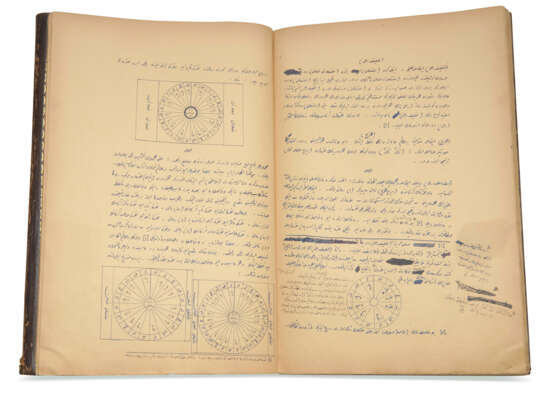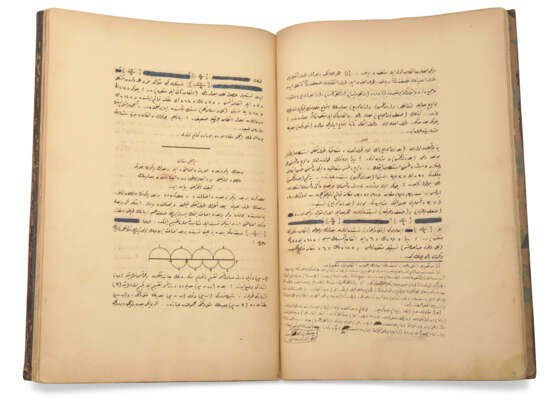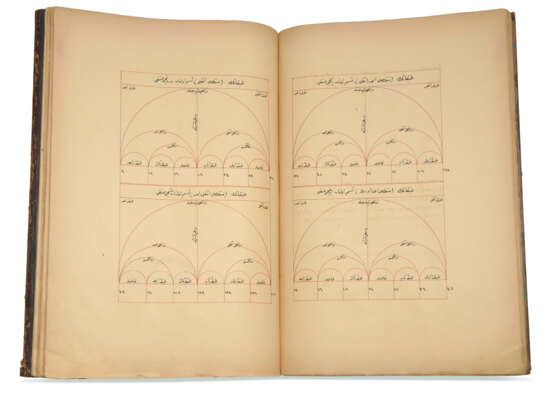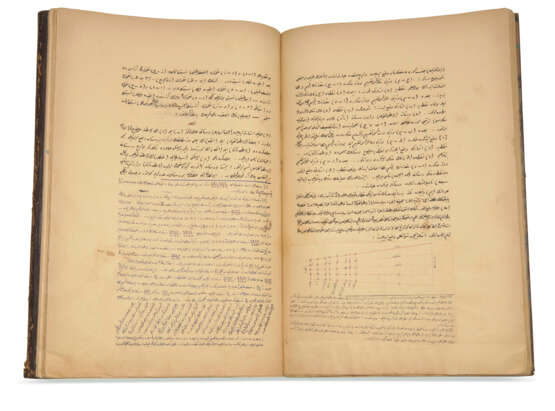ID 1053274
Лот 160 | A Theoretical Treatise on Music
Оценочная стоимость
£ 2 000 – 3 000
Al-Urmawi, Al-Risalah al Sharafiyyah fi Nisab al-ta ‘lifiyyah, in Arabic, Turkish, French and Greek, manuscript on paper [Ottoman Turkey, c.1900]
A late Ottoman copy of a seminal theoretical treatise on music, a testament to the abiding popularity of al-Urmawi's work.
c.350 x 230mm. 64 leaves, complete, 27 lines in black naskh, headings and keywords in red, extensive marginal commentaries and corrections, 72 tables and diagrams in red, 10 pages with blank tables, Osmanic letter music notation, or abced-notasi (ABECEDARY notation). Sewn on 4 cords, brown morocco gilt binding with flap.
Provenance:
(1) Sam Fogg, London, acquired in 2005 by:
(2) Schøyen Collection, MS 5279.
Text and music:
An expanded working copy of al-Urmawi’s celebrated theoretical treatise on music, Al-Risalah al Sharafiyyah fi Nisab al-ta ‘lifiyyah. The numerous diagrams include a fretboard with finger-positions and a European stave, as well as tables of scales and modes taken from al-Urmawi. The title of al-Urmawi's work refers to his patron, Sharaf al-Din Juwayni, the governor of Anatolia and then Baghdad under the first Mongol Ilkhan, Hulegu. The treatise expands on al-Urmawi’s first work, the Kitab al-Adwar, written c.1242-1258 for the last 'Abbasid caliph al-Musta'sim (r.1242-1258), which represented one of the most successful attempts to systematise Arabic music, the form of which was largely derived from the nature of the 'ud. In the al-Risalah al-Sharafiyyah al-Urmawi expands on many of the same themes, though his debt to Greek musical theory is greater in this work, possibly due to his association with Nasir al-Din Tusi, the polyglot mathematician, philosopher and vizier to Ilkhan Hulegu. Both of al-Urmawi’s works quickly became classics, particularly in the Islamic World, being the major sources for the maqams or modes which govern Arabic music. One of his major achievements was a commatic theory and system of notation standardising the intervals between the notes in the various maqams. While in the Arabic world from 18th century onwards a scale dividing the octave into 24 quartertones was increasingly in use, in the Ottoman Empire and the East, the commatic system was largely retained. The present manuscript, while retaining the commatic system, nontheless shows an awareness of European modality and notation.
| Место происхождения: | Турция |
|---|---|
| Категория аукционного дома: | Манускрипты Средневековья и Ренессанса |
| Место происхождения: | Турция |
|---|---|
| Категория аукционного дома: | Манускрипты Средневековья и Ренессанса |
| Адрес торгов |
CHRISTIE'S 8 King Street, St. James's SW1Y 6QT London Великобритания | ||||||
|---|---|---|---|---|---|---|---|
| Предосмотр |
| ||||||
| Телефон | +44 (0)20 7839 9060 | ||||||
| Комиссия | see on Website | ||||||
| Условия использования | Условия использования |








